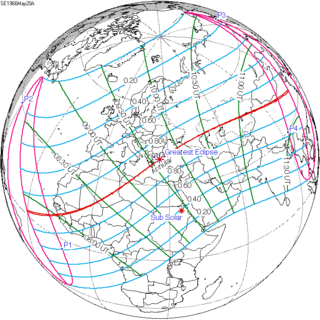
Back Сонечнае зацьменне 20 мая 1966 года Byelorussian خورشیدگرفتگی ۲۰ مه ۱۹۶۶ Persian Eclissi solare del 20 maggio 1966 Italian 1966年5月20日の日食 Japanese 1966년 5월 20일 일식 Korean 1966年5月20日日食 Chinese 1966 nî 5 goe̍h 20 ji̍t sit-ji̍t ZH-MIN-NAN
| Solar eclipse of May 20, 1966 | |
|---|---|
| Type of eclipse | |
| Nature | Annular |
| Gamma | 0.3467 |
| Magnitude | 0.9991 |
| Maximum eclipse | |
| Duration | 5 s (0 min 5 s) |
| Coordinates | 39°12′N 26°24′E / 39.2°N 26.4°E |
| Max. width of band | 3 km (1.9 mi) |
| Times (UTC) | |
| Greatest eclipse | 9:39:02 |
| References | |
| Saros | 137 (33 of 70) |
| Catalog # (SE5000) | 9434 |
An annular solar eclipse occurred at the Moon's ascending node of orbit on Friday, May 20, 1966,[1] with a magnitude of 0.9991. A solar eclipse occurs when the Moon passes between Earth and the Sun, thereby totally or partly obscuring the image of the Sun for a viewer on Earth. An annular solar eclipse occurs when the Moon's apparent diameter is smaller than the Sun's, blocking most of the Sun's light and causing the Sun to look like an annulus (ring). An annular eclipse appears as a partial eclipse over a region of the Earth thousands of kilometres wide. The Moon's apparent diameter was near the average diameter because it occurred 6.8 days after apogee (on May 13, 1966, at 14:00 UTC) and 7.2 days before perigee (on May 27, 1966, at 15:00 UTC).[2]
Annularity was visible from Guinea (including the capital city Conakry), Mali, Algeria, Libya, Greece, Turkey, the Soviet Union (today's Russia and Kazakhstan) and China. A partial eclipse was visible for parts of North Africa, Central Africa, Northeast Africa, Europe, West Asia, Central Asia, North Asia, and South Asia.
- ^ "May 20, 1966 Annular Solar Eclipse". timeanddate. Retrieved 7 August 2024.
- ^ "Moon Distances for London, United Kingdom, England". timeanddate. Retrieved 7 August 2024.
